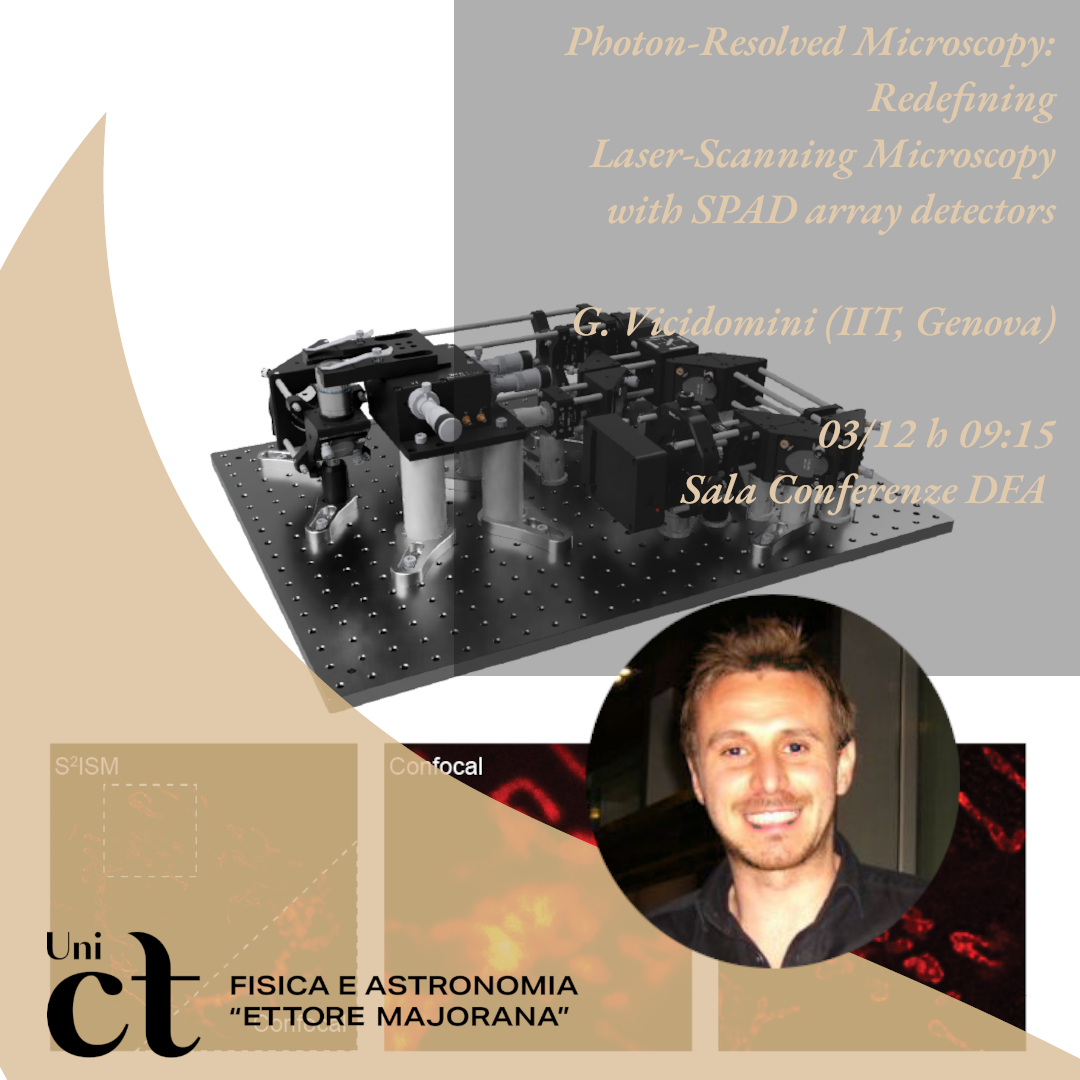Photon-Resolved Microscopy: Redefining Laser-Scanning Microscopy with SPAD array detectors

Giorno 3 dicembre 2025, con inizio alle ore 9:15, presso la Sala Conferenze del DFA, il Dr Giuseppe Vicidomini (IIT, Genova) terrà un seminario dal titolo Photon-Resolved Microscopy: Redefining Laser-Scanning Microscopy with SPAD array detectors.
Il seminario fa parte del Workshop on advanced methods for the study of Liquid-Liquid Phase Separation dynamics (PRIN 2022 PNRR - LLIPS), organizzato dal Prof. L. Lanzanò.
Tutte le persone interessate sono invitate a partecipare.
Abstract. Fluorescence laser scanning microscopy (LSM) stands as a cornerstone in the life sciences, enabling the study of complex biological processes through a unique balance of spatial and temporal resolution, imaging depth, and live-cell compatibility, while remaining compatible with advanced approaches such as spectroscopy and non-linear excitation. Yet, conventional LSM detectors are intrinsically inefficient: traditional bucket detectors integrate fluorescence over time and space, discarding the rich spatial and temporal information potentially carried by individual photons. To overcome this limitation, we have developed asynchronous read-out SPAD array detectors (1), enabling a new paradigm: photon-resolved microscopy. In this framework, every detected photon is tagged with multiple spatiotemporal signatures, unlocking information inaccessible to traditional detectors.
In this presentation, I will highlight several applications of photon-resolved microscopy, with a particular focus on image scanning microscopy (ISM). I will present reconstruction approaches ranging from basic pixel reassignment to advanced deconvolution, showing how the spatial information captured by SPAD arrays improves resolution (2) and optical sectioning (3) while reducing illumination dose. I will then discuss the integration of ISM with fluorescence lifetime imaging (FLIM), demonstrating how photon-resolved data enable super-resolved structural and functional imaging, and how lifetime information can be exploited to achieve multi-target super-resolution ISM, greatly expanding multiplexed imaging capabilities. Finally, I will briefly outline how photon-resolved microscopy synergizes with other super-resolution modalities such as STED and MINFLUX, and how SPAD arrays extend its benefits beyond imaging to fluorescence fluctuation spectroscopy (4) and single-particle tracking (5).
- Buttafava, M. et al. SPAD-based asynchronous-readout array detectors for image-scanning microscopy. Optica 7, 755 (2020).
- Castello, M. et al. A robust and versatile platform for image scanning microscopy enabling super-resolution FLIM. Nat. Methods 16, 175–178 (2019).
- Zunino, A. et al. Structured detection for simultaneous super-resolution and optical sectioning in laser scanning microscopy. Nat. Phot. 19, 888–897 (2025).
- Slenders, E. et al. Confocal-based fluorescence fluctuation spectroscopy with a SPAD array detector. Light Sci. Appl. 10 (2021).
- Bucci, A. et al. 4d single-particle tracking with asynchronous read-out single-photon avalanche diode array detector. Nat Comm. 15 (2024)
Bio. Dr. Giuseppe Vicidomini is a computer scientist working at the interface of physics, engineering, and biology, specializing in advanced optical microscopy for life science research. He earned his Diploma (cum laude) in Computer Science from the University of Genoa under Prof. Mario Bertero and Prof. Patrizia Boccacci, and completed his Ph.D. in the LAMBS laboratory under Prof. Alberto Diaspro, where he developed novel image deconvolution methods for fluorescence microscopy.
From 2008 to 2011, he was a postdoctoral fellow in the Department of NanoBiophotonics at the Max Planck Institute for Biophysical Chemistry under Prof. Stefan W. Hell (Nobel Laureate 2014). There, he introduced gated-STED, a breakthrough approach that improved STED microscopy to tens-of-nanometre resolution while significantly lowering the required light dose.
In 2011, Vicidomini joined the Italian Institute of Technology (IIT) under Prof. Alberto Diaspro, where he further advanced STED microscopy by developing time-resolved STED, a class of computational and detection strategies that overcame signal-to-noise limitations and strengthened STED resolution without compromising live-cell compatibility. Today, time-resolved STED is integrated into all commercial STED microscope platforms.
Since 2016, he has led IIT’s Molecular Microscopy and Spectroscopy (MMS) laboratory. Under his direction, the lab introduced photon-resolved microscopy, a new paradigm enabled by integrating single-photon avalanche diode (SPAD) array detectors into laser-scanning microscopy. Photon-resolved LSM captures each fluorescence photon with distinct spatial and temporal signatures, expanding spatiotemporal resolution and information content beyond conventional LSM. This work led to FLISM, a fusion of fluorescence lifetime imaging and super-resolution microscopy, now commercialized by Genoa Instruments, where Vicidomini is co-founder and scientific advisor.
His research is supported by major international funding, including an ERC Consolidator Grant (BrightEyes) aimed at developing non-invasive, real-time single-molecule imaging tools in living multicellular systems. He also leads imaging efforts for IIT’s RNA initiative and coordinates the Nanobiotechnology curriculum in the Bioengineering and Robotics Ph.D. program at the University of Genoa.